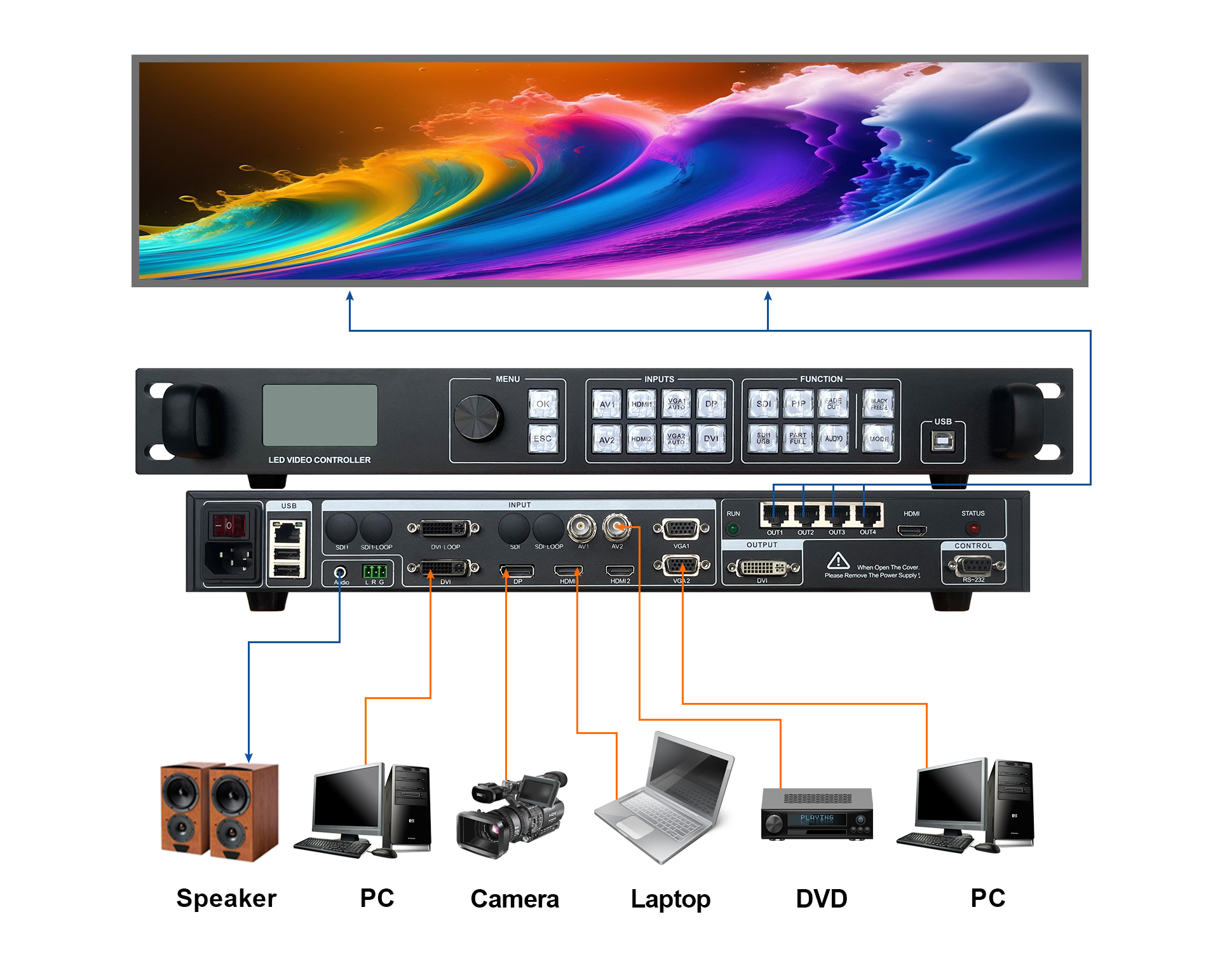
Currently, within larger LED display screens, video processors stand as crucial elements in ensuring display quality. During the installation of LED displays, the incorporation of video processors primarily addresses the following aspects:
1. Post-level nonlinear grayscale correction can be adjusted automatically or manually.
As the grayscale levels of LED displays ascend to higher thresholds, human sensitivity to lower brightness intensifies significantly. Simultaneously, sensitivity to differences in higher brightness levels becomes less acute. This circumstance results in a mismatch between the display's brightness and its actual perception by the human eye. Therefore, video processors necessitate grayscale nonlinear correction. Termed as post-level grayscale nonlinear correction, the video processor adjusts the output of LED emitters by compressing lower brightness levels and expanding higher brightness levels. This aligns the display's grayscale levels more closely with the physiological vision of the human eye. This nonlinear correction can be automated or manually adjusted, contingent upon the specific settings of the LED display and the functionalities of the video processor.
Automatic adjustment flexibly adapts based on the screen's displayed content and ambient lighting conditions, ensuring clarity and balance in the image under various brightness levels. Manual adjustment, on the other hand, grants users greater control, allowing personalized settings to achieve optimal viewing experiences. This post-level grayscale nonlinear correction is pivotal in enhancing the visual performance and user experience of LED displays. By fine-tuning the display's grayscale levels, the images appear more realistic, sharper, aligning with human visual perception characteristics, thereby delivering higher-quality visual effects.
2.The grayscale level control system governs the display of each primary color with 8 bits, totaling 24 bits of data, achieving 256 levels of grayscale for each primary color.
The grayscale level control system holds significant importance in regulating the grayscale levels of LED displays. It operates by managing 8 bits of data for each primary color (red, green, blue), amalgamating to form 24-bit data, thus facilitating 256 levels of grayscale for each primary color. This refined grayscale level control empowers LED displays to exhibit finer, richer color gradations and details.
Through this control system, LED displays can demonstrate heightened grayscale levels, transitioning from pure black to the brightest with 256 levels. This signifies precise control over the brightness and color depth of each pixel during image display, thereby producing more delicate, authentic visual effects. This capability is especially crucial in applications requiring the presentation of subtle colors and dark details, such as high-fidelity rendering of images and videos, professional image editing, and medical imaging.
The ability to control 256 levels of grayscale provides LED displays with enhanced flexibility, ensuring they deliver high-quality visual experiences across diverse environments and display requirements.
3.Image noise reduction processing: Ensuring cleaner and smoother images.
Image noise reduction processing plays a pivotal role within the LED display screen's video processor, aiming to optimize image quality and ensure displayed images are clearer, cleaner, and smoother. This processor possesses the capability to eliminate noise generated during compression or transmission processes, particularly accentuating its effect on text or detail-rich images. Through image noise reduction processing, the video processor can identify and filter noise or erratic signals present in the image, resulting in a smoother and clearer display. The 3D noise reduction function effectively reduces noise points, color variations, or other visual impurities, enhancing image cleanliness. This technology intelligently eliminates randomly occurring non-overlapping noise waves, enhancing the viewing experience by enabling viewers to focus more attentively on content without being distracted by noise. Image noise reduction processing enhances the clarity and purity of images presented on LED displays by eliminating noise and impurities, improving the viewing experience, and ensuring the visibility and readability of content.
4.Image enhancement technology and edge enhancement technology.
The image enhancement and edge enhancement technologies in video processors aim to enhance image quality through specific processing methods, focusing on sharpening image edges and recognition capabilities. Image enhancement primarily targets improving overall image quality, including enhancing contrast, color saturation, and detail clarity. This technique often utilizes spatial or frequency domain high-pass filtering methods, enhancing specific attributes of the image through specific algorithms and processing. Through this technology, images become more vivid and rich, allowing viewers to perceive finer details. Meanwhile, edge enhancement technology concentrates on improving the sharpness and prominence of image edges. This technique highlights edges and contours, making them sharper and clearer, enhancing the image's three-dimensionality and recognition. Viewers can more easily differentiate between the edges and contours of different objects in the image, enhancing the image's visibility and recognizability. Both image enhancement and edge enhancement technologies, through image processing, improve image quality and visibility, resulting in more vibrant, clear, and nuanced visuals displayed on LED screens.
5.Color Coordinate Space Transformation Technology
The application of color coordinate space transformation technology within LED display screen video processors addresses the discrepancy between video source colors and the color space used by the LED screen's light-emitting diodes. During actual display processes, differences in the color representation methods used by the video source and the LED display screen may lead to inaccurate color display or even color distortion. The key to this technology lies in intelligently adjusting and transforming the color space. The video processor converts and adjusts color data, enabling the color information from the video source to be displayed more realistically and accurately on the LED screen. Through this transformation, the video processor ensures that the colors displayed on the screen closely match those of the original video source, presenting viewers with more vibrant and accurate colors. The application of color coordinate space transformation technology provides LED displays with a more realistic and accurate color display capability. It serves as a crucial technology to ensure that viewers see image colors closer to the original video content, enhancing display effects and creating a more genuine and enjoyable viewing experience.
6.Visual Processing:
Within a video processor system, a video processor equipped with visual processing capabilities can individually adjust the brightness of each primary color (such as red, green, blue) of a single LED module and achieve color balance. The key function of this feature is to eliminate the mosaic effect that may occur due to the characteristics of LED displays. By independently adjusting the brightness and colors of each LED module, the video processor ensures better consistency in brightness between all LED modules and display units, preventing potential visual discrepancies during monochrome display. This functionality allows LED displays to demonstrate uniform color presentation and eliminates noticeable visual differences during monochrome display. Through meticulous adjustment of each primary color's brightness and hue, the video processor resolves potential issues of color or brightness inconsistencies among different modules, thereby enhancing the overall consistency of the display screen and ensuring a more stable and reliable image display.
Amoonsky, as a leader in the field of video processors, is committed to providing high-quality, professional solutions for the LED display screen industry. Our series of video processor products represent our commitment to innovative technology and exceptional quality. Whether it's color correction, image enhancement, or visual processing capabilities, our video processor series boasts robust functionalities. They are dedicated to optimizing image quality, ensuring clear, stable, and reliable display performance.
Beyond being a video processor company, Amoonsky is a partner in delivering impeccable visual experiences to our clients. With outstanding technical prowess and a professional team, we continuously inject innovation and vitality into the LED display screen industry. Choosing Amoonsky means choosing trustworthiness and professionalism. We look forward to continuing our collaboration, offering the best support for your business growth and user experience!
